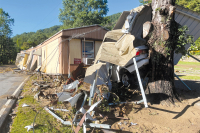WNC’s African-American history
 This is a monumental work. Ann Miller Woodford has gathered an astonishing amount of information, including old letters, church records, unpublished and previously published histories, mementos and dairies. She has spent some seven years, visiting family elders, cemeteries and the abandoned sites of churches, factories and villages.
This is a monumental work. Ann Miller Woodford has gathered an astonishing amount of information, including old letters, church records, unpublished and previously published histories, mementos and dairies. She has spent some seven years, visiting family elders, cemeteries and the abandoned sites of churches, factories and villages.
At some point, she began to weave this awesome tapestry of an “invisible culture” that not only survived trials and tribulations of the past two hundred years, but actually fostered a vital energy and grew stronger. The traces of the first African-American settlers still lingers in the remote coves and valleys and North Carolina’s “far western” counties.
The author of this work is multi-talented. Woodford sings, paints (some of her portraits are in this book); she has built a reputation as a gifted civic leader and a spiritual guide, and her presence can be detected everywhere including the schools, churches and civic organizations.
However, in regard to this book, she is best characterized as a weaver. This book is a multi-hued tapestry that blends the fragmented history, the rich oral tradition and the region’s folklore with vibrant descriptions of the lives of leaders who “have gone but are not forgotten.” Some of this tapestry is stained with blood and sweat, for poverty and racial violence have touched many of God’s children.
For example, Woodford recounts the events that led to the forced migration of African-Americans to the mountains of Western North Carolina in 1912 when racial violence in Forsyth County, Georgia, led to a “cleansing” which forced all the African-Americans in the county to abandon their homes and flee. Many of those disinherited people sought refuge in the coves and remote valleys of “the far western counties (Clay, Cherokee, Graham and the bordering counties of Macon, Jackson and Swain). Woodford finds the descendants of “the cleansing” throughout the region.
However, it should be noted that in addition to her mission to tell her story through exhaustive research, Woodford was blessed by a source of information that seemed to be both boundless and inspired. This was her father, Purel Miller, a gifted storyteller who was filled with a passion to preserve his disappearing culture.
Related Items
Purel, like his white Appalachian neighbors, came to believe that his heritage was endangered by “new customs and ideas.” Purel encouraged his daughter to gather and save the old tales and songs that sometimes blended African and Cherokee superstitions, customs and traditions. As a result, many of these stories and music were snatched from oblivion ... the old church songs and cadences that reflected the heart of African spiritual tradition.
Such old traditions as “lined” hymn singing, shouting in the spirit, calling and response singing, hand clapping, rhythmic movement and foot stomping — all were vanishing from the traditional African church and were being replaced by a more “genteel” and less emotional custom. Ann remembers that Purel often carried a tape recorder with him in order to record examples of those traditions that he often encountered. (One of the most memorable passages in this book describes an incident in which Purel wandered through the ruins of an abandoned tannery, recording what he believed to be vanquished voices, the laughter, weeping and shouts of the workers who had spent their lives there.)
Especially vivid accounts of history deal with the origin of the community of Marble which was once a thriving town where the sidewalks were made of blue marble that was locally mined. However, like some cautionary tale in the Bible, the town lost its prosperity through arrogance and poor management. The once-prosperous town vanished.
Woodford recounts the memorable local folklore about Abraham Enloe,the alleged father of Abraham Lincoln. There are marvelous bits of oral history dealing with the destruction of the Peachtree Mound — an act that angered the Cherokee spirits that resided there. There are tales of remarkable African-Americans like Aunt Til who lived to be 100 and Texana Hill McClelland, the first Black woman to live in the settlement that now bears her name, and Chrisenberry Howell, a former slave, who was a “driver of turkeys” and a man who wrote the story of his life.
Some of the most vivid stories are memorable recounts of the tragic consequences of slavery. Included are a series of interviews with slaves in Macon County that were conducted by Margaret Siler. One of her most memorable interviews is with a former slave, Uncle Matt Ray, who remembered standing on the slave block in Franklin as a child. He later carried the mail between “Old Webster” and Franklin for three years in freezing weather and laid the first bricks for the Franklin Courthouse. In the interview, “Uncle Matt” gave a detailed and graphic description of the town of Franklin in its beginning and his daunting trips across the Cowee mountains.
Woodford also gives an account of the tragic Cowee Tunnel disaster in which 19 black convicts drowned in the Tuckasegee River on Dec. 30, 1892. The victims were unable to save themselves when a barge capsized because they were shackled and chained. The victims were buried in unmarked graves (three trenches) on a nearby hillside, and later research established that none were guilty of serious offenses (loitering, gambling, vandalism, theft, etc.) There are also poignant stories about the nameless workers on the “Murphy to Manteo” railroad who died and were buried in unmarked graves near the tracks.
When All God’s Children Get Together pays tribute to a multitude of African-Americans who made significant contributions to African-American churches and schools. Some served with distinction in the United States armed services. Others built churches, taught school, served as midwives and lead blameless lives in the service of their communities. Sometimes, the photographs and tributes may appear repetitive, but that is because the spiritual leaders are multi-talented and as a consequence, they are listed again and again. Individuals like Woodford, Purel Miller, Victoria Casey MacDonald McDonald and Josephine Burgess are honored as teachers, spiritual leaders, community spokespersons and ministers. Finally, there is the organization, One Dozen Who Care, founded by Woodford— a group of dedicated individuals that made this book a reality.
So here it is ... this great multi-hued tapestry, a history studded with ancient folklore, anecdotes, humorous tales, ghost stories, “coded” song lyrics, testimonials, descriptions of slave graveyards and a great shouting and singing multitude of African-Americans — all praising the God “who has brought them a mighty long way.” Enjoy.
(Gary Carden is a writer and storyteller who lives in Sylva. He can be reached at This email address is being protected from spambots. You need JavaScript enabled to view it..)









